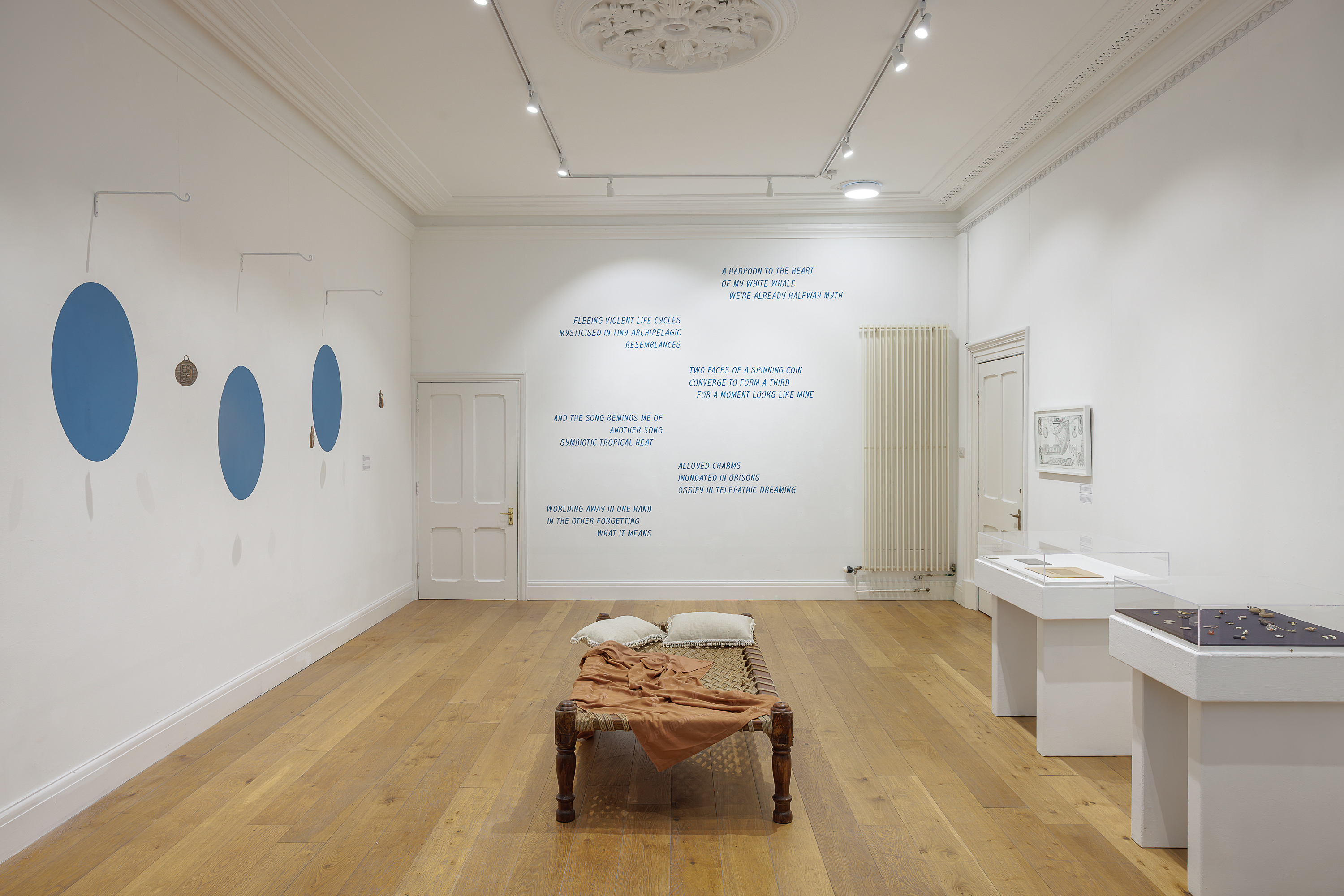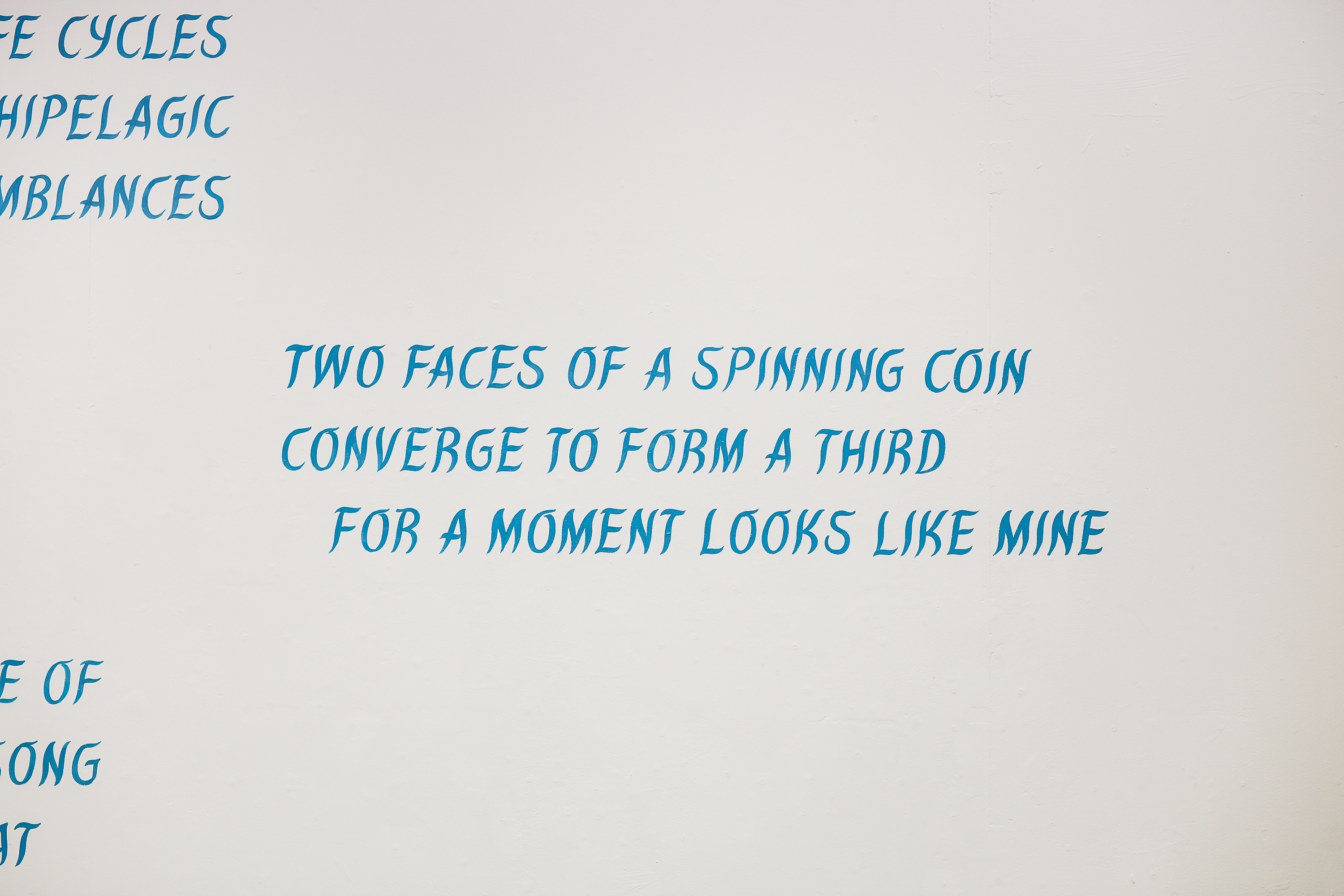AGIMAT
2025. ink pen on paper, painted wall text, bronze cast sculpture, super 16mm film (3min) 16:9, installation (daybed, cushions, airline blanket), personal charms, loans from the Edward Lovett collection and Robert Owen Museum.
solo show.
Llantarnam Grange, Cwmbran
31 May - 16 August
Agimat is a solo exhibition by Sadia Pineda Hameed that explores the history of precolonial and postcolonial charms. Through a collection of objects, sculptures, and video, Sadia considers the histories of alternative value, tokens, anting-anting (the Filipino belief in amulets and talismans), and the National Museum’s Edward Lovett charm collection, and their displacements into the museum collection. These works explore how a token can simultaneously inhabit and memorialise, gesture protest, and protect from extraction and land violence.
Agimat (3 min) is a super 16mm looping film featuring footage from a trip retracing poet Allen Ginsberg’s visit to the Llanthony Valley. A Miraculous Medallion, gifted before the trip, spins from a rearview mirror reflecting the Virgin Mary statue at Capel-y-Ffin; their alignment marking the charm’s semiotic guidance. Other charms including those from Amgueddfa Cymru - National Museum Wales’ Edward Lovett collection are spun against the sound of coins flipping, a gentle invocation for their powers to reactivate following their histories of extraction, displacement and archiving. The film meditates on the moment the symbolic materialises in a dreamlike state of passage.
Mythologies is a set of four bronze cast amulets drawing influence from anting-anting, precolonial and postcolonial Filipino spirituality, and personal and global histories; exploring the power of lorebuilding beyond fiction.
Communion is an amulet that features the time 4:59am on one side, often associated with lucid dreaming and in-between states of consciousness, with the reverse side displaying the time eight hours ahead in the Philippines. This amulet holds the power to induce telepathy, enabling communication with family across distances in the dream world.
Another amulet, Bayanihan (cooperation in Tagalog), features a nipa hut formed of match sticks, and makes reference to a Filipino tradition of communities carrying stilt houses when a family needs to moves. The reverse side features a sun reminiscent of the Filipino flag. This amulet’s power is to incite unity and collective action, particularly when rebuilding from destruction.
Love Team is a playful tribute to Guy and Pip, the manufactured love team persona of Filipino singers/actors Nora Aunor and Tirso Cruz III. One side’s design references the American influence of film and fandom culture on the Philippines; while the reverse features the imagery of a Miraculous Medallion adapted into the initials for Maria Leonora Theresa, a life-sized doll marketed as Guy and Pip’s fictional daughter who some fans believed to be a magical, alive ‘immaculate conception.’ The amulet’s power is to help true feelings surface, particularly in love, and is a talisman for emotional clarity.
The amulet Warp holds the frictions of folk Catholicism in the Philippines. It is imprinted with a grid pattern resembling a weaving draft, alluding to Filipino intuitive weaving practices such as the T’boli dream weavers. A Catholic Miraculous Medallion on a chain wraps over and around the amulet, acting as both a symbol of protection in itself, and a memorial to the violences of religious colonisation. The power of this amulet is to protect from harm and extractive energies.
Painted on the wall, Worlding traces the symbolic afterlives of memory and spiritual inheritance and mythic pursuit. Through semiotic residue and shapeshifting, the poem draws out how dislocated histories ossify into intimate, talismanic code.
Also on display are a selection of charms, both personal and from Edward Lovett’s ethnographic collection at Amgueddfa Cymru - National Museum Wales. Among them, guiding charms such as a hag stone and compass shell echo the themes of intuitive wayfinding that thread through the film Agimat. Organic materials like amber and iron pyrite are included for their long-held reputations as protective amulets, while ‘trade amulets’ such as an Indonesian fish charm or tiger teeth from Congo raise questions around displacement: where does the energy of a charm go when it is removed from its origin, and who or what is it now protecting in the context of ongoing, neocolonial resource extraction?
With thanks to Kerstin Kartscher, Uist Corrigan, Lisa Evans, Harun Morrison, Luisa Pineda Hameed, Sioned Williams, Elen Philips, Colin Laker, the Robert Owen Museum, Coles Casting and Llantarnam Grange.
Agimat is part of Perspective(s), a collaboration between Arts Council Wales and Amgueddfa Cymru - National Museum Wales, supported by the Welsh Government.
Images: Dan Weill























